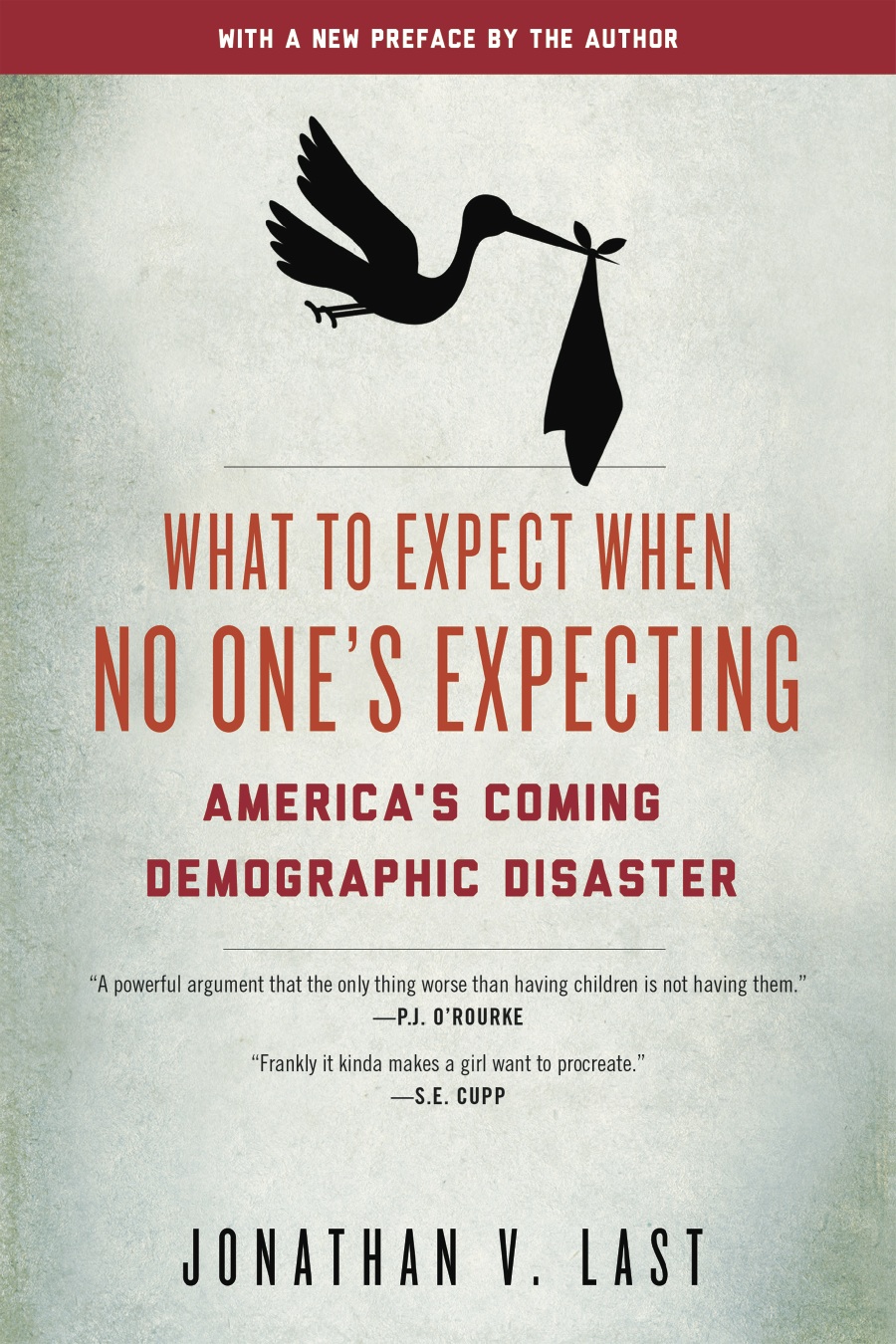October 16th, 2013
Over the years, I’ve been pretty worshipful of the New Yorker. David Grann, who’s one of my favorite writers on the planet, hangs his hat there. Plenty of other good writers, too. David Remnick’s politics are not my politics, but I am very much a fan of his writing and have always thought that the book he puts together is, on the whole, as good as you could want for a middle-brow, general-interest magazine.
Well. In the latest issue, Elizabeth Kolbert does a roundup review of books on demographics, including What to Expect. Here are the two paragraphs she devotes to my book:
In the United States, the fertility rate is currently estimated at 2.06. This figure puts the U.S. ahead of all European nations except France, and right about at replacement level. Nevertheless, according to Jonathan Last, a senior writer at The Weekly Standard, the country is facing doom by depopulation. At the start of “What to Expect When No One’s Expecting: America’s Coming Demographic Disaster” (Encounter), he breaks the number down by race, income, and education. Black women have what Last terms a “healthy” fertility rate of 1.96. Hispanic women are “doing most of the heavy lifting,” with a rate of 2.35. White women, by contrast, are slackers. Their rate is 1.79, which makes them about as productive or, if you prefer, unproductive as the Dutch and the Norwegians. Poor women generally have more kids than middle-class women, while women who drop out of high school have more than those who graduate, and way more than those who earn advanced degrees. All this adds up, Last writes, to a “kind of reverse Darwinism where the traditional markers of success make one less likely to reproduce.”
Last has aimed his book at the same sort of readers who subscribe to The Weekly Standard. He describes himself as an “anti-abortion nut job,” lampoons the “feminist-industrial complex,” and laments a decline in marriage rates among the “lower classes.” Those who find Last’s politics less than congenial are likely to be less than convinced by his arguments. Among the problems he attributes to low fertility rates is that they tend to make countries reluctant to fight wars. Among the solutions he advocates is cutting back on higher education, thereby reducing its depressing influence on American fertility.
This is like one of those moments in the movies when the masked slasher taunts his victim: “Go ahead and pray to the New Yorker! Where is your god now?”
It’s hard to know quite where to start because in the space of 281 words, Kolbert moves briskly from being confused, to uncharitable, to dishonest. For example, I wrote an entire book about the challenges low fertility rates pose for societies and what does Kolbert take away? That I think one of the “problems” with low fertility rates are that they makes countries “reluctant to fight wars.”
How could Kolbert possibly come away with that interpretation? I suspect she’s looking at this paragraph, from page 28 of WTE:
[A]n older society with fewer children will find it difficult to project power in the wider world. America’s military spending is already loaded down by retirement benefits. The Pentagon now spends 84 cents on pensions for every dollar it spends on basic pay. And whatever form our future military does take, families with just one child will be less willing to accept military casualties. The loss of a child will represent not just a tragedy, but in most cases, the end of the family line. As David Goldman ruefully notes, “A people without progeny will not accept a single military casualty.”
This paragraph, however, is about the specific problem for global stability caused by America’s inability to project power. Or, if you’d rather Kolbert’s formulation, America’s reluctance to fight wars.
However, in the next two paragraphs, I explain how we might also see the possibility of a geriatric peace as one of the benefits of low fertility. Here they are:
There is reason to believe that low fertility has had a pacifying effect on Europe, and although it is a complicated question, the general pattern holds when one glances across the globe. Countries frequently at war tend to have high fertility rates. Perpetually war-torn Rwanda, for instance, has a fertility rate of 5.43, one of the highest in Africa. Afghanistan, home to three generations of near-continuous conflict, has a fertility rate of 6.8, the highest in Asia. The Palestinian territories, a hotbed of violence, have a fertility rate of 4.7, one of the highest in the Middle East.
By contrast, even in unstable regions, the countries with relatively low fertility rates tend to be more peaceable. Mauritius, South Africa, and Gabon have the lowest fertility rates in Africa, and are among the continent’s most stable nations. Israel and Qatar have the lowest fertility rates in the Middle East and are two of the least belligerent states in the neighborhood. In volatile South Central Asia, the lowest fertility rate is claimed by Kazakhstan, a stable, modernizing country.
I’ll let readers decide if they think Kolbert’s characterization of my view of fertility rates, war, and peace is either accurate or fair.
To pick another example, Kolbert writes that “Last has aimed his book at the same sort of readers who subscribe to The Weekly Standard. He describes himself as an ‘anti-abortion nut job’ . . .” Again, the context here suggests something very different from what Kolbert is presenting to readers. Here’s the actual passage from page 59:
Before you start flipping ahead, let me make a promise. Yes, I’m one of those anti-abortion nut jobs who thinks that every embryo is sacred life and abortion is killing an innocent and blah-blah-blah. But when it comes to abortion, most Americans aren’t crazies like me—they think abortion should be, in essence, legal, but somewhat restricted, and rare. So without my pushing judgments of any kind, let me just give you the brief demographic tour as to how abortion has affected American fertility. . . .
Then there’s Kolbert’s use of “scare quotes” in the passage on how I lament “a decline in marriage rates among the ‘lower classes.’” As if the implosion of the marriage culture among the less-educated and less-wealthy isn’t true because a conservative is saying it. Perhaps she wouldn’t have felt the need for scare quotes if the information was coming from a fellow liberal, such as Isabel Sawhill at Brookings. So here’s Sawhill on the subject, just in case it makes Kolbert feel more comfortable: “marriage is displacing both income and race as the great class divide in America.”
One gets the sense that for Kolbert the only part of What to Expect that actually registered with her was the information that I work at The Weekly Standard. That was the cue she needed to know what to think.
-
“One gets the sense that for Kolbert the only part of What to Expect that actually registered with her was the information that I work at The Weekly Standard. That was the cue she needed to know what to think.”
Well, yes. I can understand your disappointment, but are you really surprised?
-
All these dentist office mags are going into the Carrie Bradshaw hausfrau sneer-a-thon now. Remnick will be political chief of TheFrisky or Dlisted by this time next year
-
Hi Jonathan,
Have enjoyed your writing for quite awhile, and fairly recently subscribed to TWS . . . guess I’m one of ‘those’ people.It is my guess that part of Kolbert’s rather histrionic review of your book is that it gently challenges the notion that women ought not feel any personal responsibility to propagate the race, nor feel obligated to be primarily responsible for child rearing.
At least that’s the only way it is obvious for me to rationalize her rather strident attack on you and your background at TWS. The ‘theory’ that declining population trends for a significant period of time is neither new, nor often challenged by any intellectually honest well read person (don’t need to be either very bright or well educated to understand the problems with this kind of demographic trend, and there are many historical and recent illustrations).
Left unspoken is the very great irony that the very same highbrow liberals that subscribe to the New Yorker were the same ‘class’ of intellectual liberals (modern, not classic) that were not so long ago the ardent supporters of eugenics, precisely because they did not approve of the overbreeding of those less ‘desirable’ elements of society (dark skinned, less intelligent/educated, etc).
> these folks still today ardently support eliminating less desirable people via unlimited taxpayer funded abortion.Best Regards,
-
[…] The New Yorker and ‘What to Expect’ — Jonathan Last Online […]
-
Kind of disappointing that the New Yorker apparently isn’t much different from people who post 1-star Amazon reviews on the day books are released by authors they don’t like. There is one guy who has posted 400 or so 1-star reviews of books by conservatives; I’m sure he has spent $5,000 plus on books he hates.
-
How ironic to get such short shrift in a magazine that can hardly seem to bring articles in under 30k words (that’s an estimate; I never actually found the end of any NYer article I started). It would have been better to be the inspiration for a dry, nonsensical cartoon. “I really only object to abortion because Halliburton employees are threatening to unionize,” says a duck sitting in a barber’s chair.
-
I know from reading your writing how much you enjoy the New Yorker. I’m sorry that the reviewer was so shallow about critiquing your book. Hopefully your protest here will bring a reconsideration.
-
I haven’t shared anything near your affection for the NYer since Rik Hertzberg came aboard. His notions are like a fart that refuses to leave your elevator car. Anything that I like there is by accident, and I pick through the contents the way I used to separate peas from carrots. Why? Because I know what they think of me. The whole book is not for people who are “not like us.” It reflects NYC’s prevailing culture. Some of the most insipidly parochial people I know are New Yorkers who truly believe that they’re open-minded cosmopolitans. It would be funny if it were funny.
-
The problem is that some liberals think all conservatives are jerks. And that is just not true. It is also not true that liberals are all communists. I am a liberal and I did not think that the book was only for conservatives. Every one agrees low birth rates are eventually a problem. The difference is where some people are so wrapped up in worry about the caring capacity of the earth and the ability to feed every one they they will not see a problem until every country in the world has a birth rate like Singapore .7 per woman.
But the truth is the problem of making sure we have enough food can be resolved by by putting a 10 cent a pound tax on beef and encouraging people to eat chicken. The problem of global warming could be solved by building 300 nuclear power plants. Both problems would cost money, but 1 year of economic growth at 5% would pay for all of it or 2 years at 2.5%.
The problem is on so many questions conservatives and liberals just talk about very different problems. Global warming is a big problem if ignored most main stream scientists on PBS say so. But fixing it is not that big of a deal or even that hard.
Falling birth rates is interesting at the level we are at now of 2.06 children per women. But not necessary earth shattering what is earth shattering and (even liberals like me would think so) is if the whole world goes to Japan levels like 1.4.
The part about the book every one ignores is the that almost never does the birth rate stop falling. Really, that is the most interesting part of the book that is the warning message of the book and all any one is talking about is the 2 or 3 paragraphs on abortion. And the 2 or 3 paragraphs on global warming.
-
To sum up the New Yorker’s review: “Ooh, cooties!”
-
[…] Jonathan Last, author of “What to expect when no-one’s expecting” (Amazon UK|US) has some issues with the way the review treats his […]
-
JVL’s actual serious engagement of Ms. Kolbert (given her almost certainly calculated, craven hitjob) indicates that he’s either naive or remarkably gracious/magnanimous. I’ll say 10/90 Naive/Gracious.
And then I’ll say, for the hell of it, “Let’s show ’em what’s cookin’ in Atlanta, GA tonight”
-The Nature Boy -
She’d probably count your whole anti-Romney-hippie-vegetarian-and-married-to-a Smith-alum against you, too. On the other hand, you always wanted to be in the New Yorker…voila!
I like Joe’s idea. This opens up a world of cartoon caption contest possibilities. We, too, can just pick random “provocative” lines from your book without actually reading it or engaging with it honestly…and append them beneath our favorite cartoons. (Some of them might make more sense that way.)
What can we do with: “When you game it out, Iran would be foolish not to try for nuclear weapons.” Or: “For instance, the government instituted a program to convert local prostitutes into elder-care nurses.” Or: “Immigration isn’t as good for your demographic profile as baby-making.” This could be fun!
-
“America is not Georgia.” Well, duh. Obviously, Last is a simpleton. He only wishes America were like Georgia, though he doesn’t really specify which Georgia–Stalin’s Georgia or Margaret Mitchell’s Georgia. Avoid this book.
You’re right, GW, this is fun.
-
The latest issue of TNY has a piece by Evgeny Morozov that reviews several recent books on boredom/constant connectivity. One of them is “The Present Shock” by Douglas Rushkoff. Only… that’s not the name of the book. It’s just “Present Shock”, after, of course, Alvin Toffler’s “Future Shock”. In the big scheme, this is a small error, but it sure is a noticeable one, and a weird one — it’s a dad-ism, adding a definite article to a title when it ain’t yer turn to add a definite article to a title — and most of all a surprising one to make it through all of the layers I would presume they’d have there.







New Yorker Botches ‘What to Expect’ October 16, 2013 at 2:43 pm
[…] New Yorker's Elizabeth Kolbert writes about Jonathan V. Last's book What to Expect When No One's Expecting and gets it completely […]